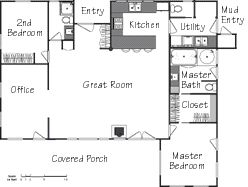 Passive Solar House Design
Passive Solar House Design  Passive Solar House Design
Passive Solar House Design The house was designed by David Wright, an architect based in Grass Valley who has specialized in passive solar design for over 30 years. The goal was to design a modest-sized house (1400-1600 square feet) that was easy to live in and very efficient to heat and cool. Though I haven't yet lived in the house (as of 2/19/00 we're in the drywall phase), I'm very happy with the plan that David developed.
Geographically, we are located in a valley at around 750-foot elevation in California's Sierra foothills. The South Fork of the American River flows through this valley, and in fact is approximately 50-120 feet from the south wall of the house, depending on the river level.

Trees to the west of the building site.
Winter temperatures rarely stay below freezing for more than a few days, and we get quite a bit of winter sun. Cooling is more of a challenge in this climate, where summertime highs are commonly in the 90's (all temperatures in degrees Fahrenheit) and occasionally between 100 and 110. We are fortunate, however, that the humidity stays relatively low, and that the temperature almost always cools down into the 60's at night.
 A rough sketch of the floor plan is shown at right (there's also a larger version). Total conditioned space is 1550 square feet. The driveway approaches the entry (top of plan) from the north. The river runs roughly parallel to the south walls (bottom of plan). East and west are sheltered by small rises and lots of trees. A bank of windows on the south side of the house will bring in the winter sun so that it can heat the slab and radiate warmth. In the summer, the sun is of course higher in the sky so not as much warming sunlight comes in.
A rough sketch of the floor plan is shown at right (there's also a larger version). Total conditioned space is 1550 square feet. The driveway approaches the entry (top of plan) from the north. The river runs roughly parallel to the south walls (bottom of plan). East and west are sheltered by small rises and lots of trees. A bank of windows on the south side of the house will bring in the winter sun so that it can heat the slab and radiate warmth. In the summer, the sun is of course higher in the sky so not as much warming sunlight comes in.
There is no air conditioning, an unusual decision in this area. Thus passive cooling plan is to keep the house closed during the day, relying on the good insulation of walls, roof, and windows, and to open it up at night. David specified operable skylights on the highest ridge line, with a reversible ceiling fan. With open windows below to pull in cool air, the ceiling fan can help vent the hot air out the skylights, cooling off the inside air and allowing the slab to release heat that it has absorbed during the day. When it starts to warm up outside, we will close up the windows, and expect the slab to absorb heat, keeping the house comfortably cool during the day.
My one concern is the office, located on the west side of the house and containing heat-producing computer and laser printer. (And let's face it, when it gets too hot in the office, I get sleepy and can't work!) A good stand of trees protects the west side of the house from the full force of the sun, however, and if that is not sufficient, we can install a room-sized air conditioner in the wall of the office.
The home's riverfront location also contributes to the cooling picture. The air temperature near the river is generally lower than "inland" air. In the late afternoons, you can feel a cool breeze coming off the water. However, the air near the river is also a bit more humid than it is even 1/2 mile away, making a swamp cooler not an effective cooling solution. On balance, I'd rather be by the river!
 The elevation drawing to the right shows the north side of the house. (Sorry about the chopped off right side, the drawing was too big for my scanner.) The doorway to the right of center is the front entry. The odd set of windows (one large and two small) are in the kitchen. The two skinny windows are in the two front bathrooms. Click on the drawing or click here to see a larger version.
The elevation drawing to the right shows the north side of the house. (Sorry about the chopped off right side, the drawing was too big for my scanner.) The doorway to the right of center is the front entry. The odd set of windows (one large and two small) are in the kitchen. The two skinny windows are in the two front bathrooms. Click on the drawing or click here to see a larger version.
 To the left is the south elevation, facing the river. The office is on the left, great room in the center, master bedroom on the right. The porch roof in front of the great room will be covered with a translucent or transparent glazing to let in the winter sun. In the summer we will need to cover it somehow. Haven't yet figured out how to do that. The budget options include bamboo or shadecloth. (These may be the short term solution.) For longer term, some sort of wood slats would be nice, and the ultimate would be a living cover such as a grapevine that would shed its leaves in the winter to let the sun through.
To the left is the south elevation, facing the river. The office is on the left, great room in the center, master bedroom on the right. The porch roof in front of the great room will be covered with a translucent or transparent glazing to let in the winter sun. In the summer we will need to cover it somehow. Haven't yet figured out how to do that. The budget options include bamboo or shadecloth. (These may be the short term solution.) For longer term, some sort of wood slats would be nice, and the ultimate would be a living cover such as a grapevine that would shed its leaves in the winter to let the sun through.
 On the right is the east elevation. The house is symmetrical, so the west looks the same except that it has just three windows and no doors. This elevation shows the gable windows that are at each end of the great room.
On the right is the east elevation. The house is symmetrical, so the west looks the same except that it has just three windows and no doors. This elevation shows the gable windows that are at each end of the great room.
From the beginning, the goal has been to choose materials that are efficient, pleasant to live with, and durable. "Solid" is much more important to us than "fancy" (or "expensive").
We took David Wright's suggestion and used structural insulated panels instead of conventional framing. They are highly energy-efficient, and the resulting house should be quite square (true lines, not skewed), and have excellent shear strength. Though the panels are abouit 10% more expensive than conventional framing and were a bit more challenging to work with than expected, we believe that the finished product will be worth the extra effort. You'll see more information about the panels and the process of building with them in the diary (see link below).
We chose to build on a concrete slab, with radiant heating in the slab. The mass of the slab helps in both heating and cooling. The intricacies of the slab are also discussed in the diary (1st installment).
First Installment of the Diary